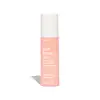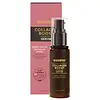What's inside
What's inside
 Key Ingredients
Key Ingredients

 Benefits
Benefits

 Concerns
Concerns

 Ingredients Side-by-side
Ingredients Side-by-side

Water
Skin ConditioningSodium Ascorbyl Phosphate
AntioxidantCoco-Caprylate
EmollientGlycerin
HumectantNiacinamide
SmoothingCetearyl Olivate
Citric Acid
BufferingSorbitan Olivate
EmulsifyingGlyceryl Caprylate
EmollientXanthan Gum
EmulsifyingSaccharide Isomerate
HumectantJojoba Esters
EmollientTocopherol
AntioxidantBisabolol
MaskingZingiber Officinale Root Extract
MaskingHelianthus Annuus Seed Oil
EmollientTerminalia Ferdinandiana Fruit Extract
AntioxidantSodium Hyaluronate
HumectantRosmarinus Officinalis Leaf Extract
AntimicrobialPolyglycerin-3
HumectantSodium Citrate
BufferingCaprylhydroxamic Acid
Lecithin
EmollientSclerotium Gum
Emulsion StabilisingSodium Phytate
Alcohol Denat.
AntimicrobialSilica
AbrasivePullulan
Helianthus Annuus Seed Wax
Skin ConditioningParfum
MaskingWater, Sodium Ascorbyl Phosphate, Coco-Caprylate, Glycerin, Niacinamide, Cetearyl Olivate, Citric Acid, Sorbitan Olivate, Glyceryl Caprylate, Xanthan Gum, Saccharide Isomerate, Jojoba Esters, Tocopherol, Bisabolol, Zingiber Officinale Root Extract, Helianthus Annuus Seed Oil, Terminalia Ferdinandiana Fruit Extract, Sodium Hyaluronate, Rosmarinus Officinalis Leaf Extract, Polyglycerin-3, Sodium Citrate, Caprylhydroxamic Acid, Lecithin, Sclerotium Gum, Sodium Phytate, Alcohol Denat., Silica, Pullulan, Helianthus Annuus Seed Wax, Parfum
Maris Aqua
HumectantNiacinamide
SmoothingGlycerin
HumectantHelianthus Annuus Seed Oil
EmollientCoco-Caprylate
EmollientLysolecithin
EmulsifyingSclerotium Gum
Emulsion StabilisingXanthan Gum
EmulsifyingPullulan
Acetyl Glucosamine
Skin ConditioningSilybum Marianum Ethyl Ester
Skin ConditioningSimmondsia Chinensis Seed Oil
EmollientRosa Canina Seed Oil
EmollientDehydroacetic Acid
PreservativeBenzyl Alcohol
PerfumingSodium Hyaluronate
HumectantBisabolol
MaskingParfum
MaskingMaltodextrin
AbsorbentRubus Fruticosus Leaf Extract
MaskingPanthenol
Skin ConditioningTetrasodium Glutamate Diacetate
Tocopheryl Acetate
AntioxidantPotassium Sorbate
PreservativeAloe Barbadensis Leaf Juice
Skin ConditioningLactic Acid
BufferingPisum Sativum Extract
Skin ConditioningCyclodextrin
AbsorbentMaris Aqua, Niacinamide, Glycerin, Helianthus Annuus Seed Oil, Coco-Caprylate, Lysolecithin, Sclerotium Gum, Xanthan Gum, Pullulan, Acetyl Glucosamine, Silybum Marianum Ethyl Ester, Simmondsia Chinensis Seed Oil, Rosa Canina Seed Oil, Dehydroacetic Acid, Benzyl Alcohol, Sodium Hyaluronate, Bisabolol, Parfum, Maltodextrin, Rubus Fruticosus Leaf Extract, Panthenol, Tetrasodium Glutamate Diacetate, Tocopheryl Acetate, Potassium Sorbate, Aloe Barbadensis Leaf Juice, Lactic Acid, Pisum Sativum Extract, Cyclodextrin
Ingredients Explained
These ingredients are found in both products.
Ingredients higher up in an ingredient list are typically present in a larger amount.
Bisabolol is famous for its skin soothing properties. It does this by blocking inflammatory signals, helping to reduce your body's reaction to irritation.
This ingredient also interferes with the process of hyperpigmentation. This can help with reducing dark spots and uneven tone.
Bisabolol is an antioxidant. Antioxidants help fight free-radicals. Free-radicals are molecules that may damage your skin cells. By fighting these free-radicals, Bisabolol may slow down signs of aging.
Studies have shown Bisabolol to have antimicrobial properties and may be a fungicide. These properties help preserve a product's shelf life.
All these properties makes bisabolol a great skin barrier helper ingredient.
Bisabolol also helps the absorption of other ingredients.
Note: Synthetic Bisabolol has been shown to be less effective.
Learn more about BisabololCoco-Caprylate is created from fatty coconut alcohol and caprylic acid.
It is a lightweight emollient. Emollients create a thin barrier on the skin to trap moisture in. This helps keep your skin hydrated and soft.
Once applied, Coco-Caprylate is absorbed quickly and leaves a silky feel. It may help solubilize other ingredients, or help other ingredients be dispersed evenly.
Coco-Caprylate may not be fungal acne safe.
Learn more about Coco-CaprylateGlycerin is already naturally found in your skin. It helps moisturize and protect your skin.
A study from 2016 found glycerin to be more effective as a humectant than AHAs and hyaluronic acid.
As a humectant, it helps the skin stay hydrated by pulling moisture to your skin. The low molecular weight of glycerin allows it to pull moisture into the deeper layers of your skin.
Hydrated skin improves your skin barrier; Your skin barrier helps protect against irritants and bacteria.
Glycerin has also been found to have antimicrobial and antiviral properties. Due to these properties, glycerin is often used in wound and burn treatments.
In cosmetics, glycerin is usually derived from plants such as soybean or palm. However, it can also be sourced from animals, such as tallow or animal fat.
This ingredient is organic, colorless, odorless, and non-toxic.
Glycerin is the name for this ingredient in American English. British English uses Glycerol/Glycerine.
Learn more about GlycerinHelianthus Annuus Seed Oil is the oil derived from the seeds of a Sunflower. Sunflower seed oil is non-fragrant. It is an emollient, meaning it helps to soften the skin.
Sunflower seed oil contains many fatty acids. The fatty acids found in sunflower seeds include (from highest amount to least): linoleic acid, myristic acid, palmitic acid, stearic acid, arachidic acid, oleic acid, and linolenic acid.
These fatty acids help the skin create ceramides. Ceramides play a role in repairing the skin barrier.
Helianthus Annuus Seed Oil helps moisturize the skin. This in turn helps the skin look more rejuvenated and smoother.
Sunflowers are rich in vitamin E.
Historians believe Indigenous cultures of North America domesticated sunflowers before corn. Thus they relied on sunflower oil for a variety of uses. One such use is moisturizing skin and hair.
Sunflower seed oil may not be fungal acne safe. We recommend speaking with a professional if you have any concerns.
Learn more about Helianthus Annuus Seed OilNiacinamide is a multitasking form of vitamin B3 that strengthens the skin barrier, reduces pores and dark spots, regulates oil, and improves signs of aging.
And the best part? It's gentle and well-tolerated by most skin types, including sensitive and reactive skin.
You might have heard of "niacin flush", or the reddening of skin that causes itchiness. Niacinamide has not been found to cause this.
In very rare cases, some individuals may not be able to tolerate niacinamide at all or experience an allergic reaction to it.
If you are experiencing flaking, irritation, and dryness with this ingredient, be sure to double check all your products as this ingredient can be found in all categories of skincare.
When incorporating niacinamide into your routine, look out for concentration amounts. Typically, 5% niacinamide provides benefits such as fading dark spots. However, if you have sensitive skin, it is better to begin with a smaller concentration.
When you apply niacinamide to your skin, your body converts it into nicotinamide adenine dinucleotide (NAD). NAD is an essential coenzyme that is already found in your cells as "fuel" and powers countless biological processes.
In your skin, NAD helps repair cell damage, produce new healthy cells, support collagen production, strengthen the skin barrier, and fight environmental stressors (like UV and pollution).
Our natural NAD levels start to decline with age, leading to slower skin repair, visible aging, and a weaker skin barrier. By providing your skin niacinamide, you're recharging your skin's NAD levels. This leads to stronger, healthier, and younger looking skin.
Another name for vitamin B3 is nicotinamide. This vitamin is water-soluble and our bodies don't store it. We obtain Vitamin B3 from either food or skincare. Meat, fish, wheat, yeast, and leafy greens contain vitamin B3.
The type of niacinamide used in skincare is synthetically created.
Learn more about NiacinamideParfum is a catch-all term for an ingredient or more that is used to give a scent to products.
Also called "fragrance", this ingredient can be a blend of hundreds of chemicals or plant oils. This means every product with "fragrance" or "parfum" in the ingredients list is a different mixture.
For instance, Habanolide is a proprietary trade name for a specific aroma chemical. When used as a fragrance ingredient in cosmetics, most aroma chemicals fall under the broad labeling category of “FRAGRANCE” or “PARFUM” according to EU and US regulations.
The term 'parfum' or 'fragrance' is not regulated in many countries. In many cases, it is up to the brand to define this term.
For instance, many brands choose to label themselves as "fragrance-free" because they are not using synthetic fragrances. However, their products may still contain ingredients such as essential oils that are considered a fragrance by INCI standards.
One example is Calendula flower extract. Calendula is an essential oil that still imparts a scent or 'fragrance'.
Depending on the blend, the ingredients in the mixture can cause allergies and sensitivities on the skin. Some ingredients that are known EU allergens include linalool and citronellol.
Parfum can also be used to mask or cover an unpleasant scent.
The bottom line is: not all fragrances/parfum/ingredients are created equally. If you are worried about fragrances, we recommend taking a closer look at an ingredient. And of course, we always recommend speaking with a professional.
Learn more about ParfumPullulan is a low viscosity polysaccharide (a long chain carbohydrate) with binding and film forming properties when dissolved in water. It is used to create a "silicone-like" or silky feel in cosmetics without adding viscosity.
According to a manufacturer, this ingredient's ability to easily dissolves makes it a great carrier for active ingredients.
Due to it being edible and tasteless, you'll likely find this ingredient in breath freshener strips. This ingredient is produced from the starch of the fungus, Aureobasidium pullulans.
Pullulan is stable over a broad-range of pH.
Learn more about PullulanSclerotium Gum is a polysaccharide gum made by the fungus, Sclerotium rolfssii. It is similar to xanthan gum.
In cosmetics, Sclerotium Gum is used to thicken the texture and to help stabilize other ingredients.
As an emulsifier, Sclerotium Gum helps prevent ingredients from separating, such as water and oil.
Learn more about Sclerotium GumSodium Hyaluronate is hyaluronic acid's salt form. It is commonly derived from the sodium salt of hyaluronic acid.
Like hyaluronic acid, it is great at holding water and acts as a humectant. This makes it a great skin hydrating ingredient.
Sodium Hyaluronate is naturally occurring in our bodies and is mostly found in eye fluid and joints.
These are some other common types of Hyaluronic Acid:
Learn more about Sodium HyaluronateXanthan gum is used as a stabilizer and thickener within cosmetic products. It helps give products a sticky, thick feeling - preventing them from being too runny.
On the technical side of things, xanthan gum is a polysaccharide - a combination consisting of multiple sugar molecules bonded together.
Xanthan gum is a pretty common and great ingredient. It is a natural, non-toxic, non-irritating ingredient that is also commonly used in food products.
Learn more about Xanthan Gum